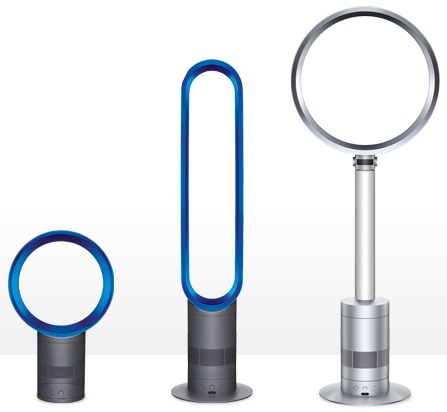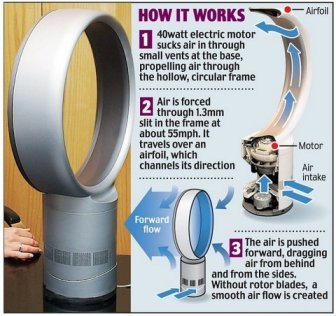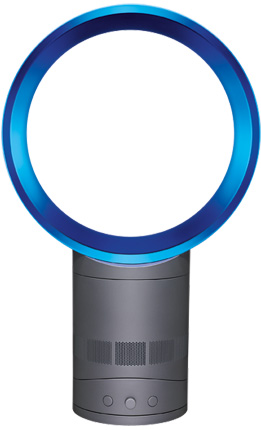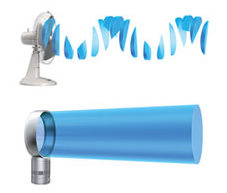Bladeless Fan
- Aug. 08, 2010.

(Bladeless Fans)
What is a bladeless fan?
A bladeless fan works like a jet engine, sucking air into a cyclone accelerator that amplifies it 15 to 18 times before blowing it out over an airfoil-shaped ramp. As that air is blown out, more is sucked in from behind. With no blades, the air stream is smooth and the contraption is easy to clean. The fan runs on a modest 40-watt motor.
How does a bladeless fan work?

Step1: Air is drawn in
Up to 5.28 gallons of air per second is drawn in by an energy-efficient, brushless motor. A combination of the technologies used in turbochargers and jet engines generates powerful airflow.
Step2: Air is accelerated
Airflow is accelerated through an annular aperture. It passes over a 16° airfoil-shaped ramp, which channels its direction.
Step3: Air is induced
Air behind the Dyson Air Multiplier™ fan is drawn into the airflow, through a process known as inducement.
Step4: Air is entrained
Air around the machine is also drawn into the airflow, through a process known as entrainment, amplifying it 15 times.
What are the advantages of a bladeless fan?
#1 Sleek looking:
 It is lovely and you might say a work of Art. Imagine you have such a sleek looking device in your home...
It is lovely and you might say a work of Art. Imagine you have such a sleek looking device in your home...#2 no nasty blades to get fingers caught up in, safe. This is good for family with kids.
#3 Blades cause buffeting. This fan has no buffeting.
 The blades on conventional fans cause unpleasant buffeting because they chop the air before it hits you. This bladedeless fan amplifies surrounding air, giving an uninterrupted stream of smooth air.
The blades on conventional fans cause unpleasant buffeting because they chop the air before it hits you. This bladedeless fan amplifies surrounding air, giving an uninterrupted stream of smooth air.What are the disadvantages of a bladeless fan?
#1 Noisy
When this device is fully operated, you can have some sense of a mini-vacuum cleaner. But when it's half operated, it’s really nice and smooth breeze.
#2 Too expensive
A normal fan is $20, but this device costs $300.00. The good news is that some factories in Taiwan and China are manufacturing the similar devices for $50–$65. So hopefully, this retail price will drop to half of it - $150 soon.
Who invented bladeless fan?
In October 2009, James Dyson's consumer electronics company,introduced a bladeless fan called Dyson Air Multiplier.
However, documents at the Intellectual Property Office, formerly the Patent Office, indicate that Dyson re-submitted its application for a worldwide patent last year after the IPO ruled that its initial design was too similar to the Japanese invention. The Dyson version, "cannot be considered novel or cannot be considered to involve an inventive step", the initial ruling from the IPO suggested.
Patents expire after 20 years, but even after that date they can not be submitted by a different person or company unless they have been changed or improved upon.
Dyson's most recent patent applications, which are still pending, have been changed to highlight a key design feature of the Air Multiplier: a Coanda surface. This is the aerofoil ramp over which the air is pushed out of the ring of the fan. Because of the angle of the Coanda surface, the air sucks in surrounding air into the air flow, creating a smooth and powerful blast of air for any office worker using the fan.
Gill Smith, the head of Dyson's patent department, said: "We wouldn't dream of denying that the Japanese arrangement and our fan look very similar. The difference is all in the technology. We've spent many years developing the Coanda surface. The Japanese version does not have this feature."
She said that she "absolutely expected" Dyson to be granted a patent for its Air Multiplier. The most recent patent application has not fallen into the "not novel" category that the initial application suffered from.
How much is a bladeless fan?
Dyson quoted $299 for its 10” fan on its official site.
We’re helping our customers buying from a factory here at a price of $55. The noise level of this $55 is bigger than Dyson’s fan, but the factories here are making a new generation bladeless fan which is very close to the noise level of Dyson’s fan. The wind output will be bigger than Dyson’s fan.
This new generation fan will come out after 20-30 days. Price will be about $55-$65.
Bladeless fan(Dyson) reviews:
dejima says on June 22, 2010 at 2:42 pm:
I really like dysons tech. Only things is it not attainable by the mass. Not everyone has $500 to drop on a fan.
dejima says on June 22, 2010 at 2:58 pm:
If dyson is really trying to combat air-con, this make this affordable, then not only can a no one match the tech, but no one would be able to touch them in the market.
ifrit says on June 22, 2010 at 4:37 pm:
I’m sorry but despite the lovely designs, Dyson is nothing more than a self propelled hype machine. One who is not above lying about their products (Blade style hand dryers have been used in Japan for at least the past decade).
perfectcirclecarpenter says on June 23, 2010 at 2:57 am:
Hide the fan blades in a cyclone and call it the new fan, then mark up the price tag of the plastic contraption 1000%. At least they are cool to look at.
The guy knows how to fool em, but this ain’t nuthin new.Run a culvert through the stable temperature of earth berms beside the house, and let the chimney effect pull it in, that’s real genius.
I still can’t find a single article about Michael Reynolds work on your site. Are you guys daft? The guy is at the top of the green revolution.
forrestrm says on June 23, 2010 at 11:12 am:
If a fan is bladeless then is it really a fan? Anyway, Dyson’s own web page explains their new device and it has fan blades – they just don’t have to be as fast moving, and so I presume are quieter and use less energy. The real innovation is the induction and amplification of that air movement. But don’t call it bladeless.
agrajag says on June 24, 2010 at 4:19 am:
This is just a fan. It doesn’t do anything a normal $20 fan doesn’t do, it moves air around, which is useful, but hardly a replacement for AC. (you can run your AC in fan-only mode, and save 95% of the energy, but people dont — I wonder why ?)
The main difference between this, and an average fan, is a) that it looks interesting, and b) that it costs 20 times the price. Neither of these two properties will do anything at all to reduce AC-usage.
greginmichigan says on July 3, 2010 at 12:15 pm:
This could possibly be modified to create something truly spectacular. I’m buying one to invent or recreate something special. Perhaps I’ll return here to let others know. This seems to cool better because it seems to move a lot more air, but the air needs to be chilled a bit by something. I don’t know if 40 watts is a lot of energy, compared to other fans, it’s probably more efficient which can save energy money spent over time if you use a fan.
larry chavez says on July 7, 2010 at 1:21 pm:
I bought a 10? Dyson fan. It is lovely and you might say a work of Art…..But,….I have returned it for a refund..reason…its too noisey. You place it next to a regular fan of the same size and you immediately hear the difference. It also seems to hit a certin freq that after 20min or so, you start experiencing a headache……What a shame
dw@sci says on July 7, 2010 at 2:01 pm:
Myself and my company already built these for military use so our troops could set them up simply in these desert, or anywhere they needed “heating or cooling.” As a lucky side output, it can also heat and cool liquids.Currently, we are working at removing the IED from being the life taker (as well as land mines, etc.) and/or destroyer…
Best, David WoronerCEO/SCI
ccalde1961 says on July 17, 2010 at 11:35 pm:
Dyson lives in England where the people think 80F is Very HOT Summer weather. He would be throwing his little loop out the window within an hour,if he had to be living and sleeping with only his invention to keep him cool in the heat and humidity this past Summer in the mid-Atlantic states of the USA 2010.
>> Return to China bladeless fan. from Bladeless fan.